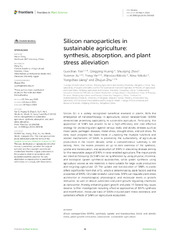| dc.creator | Yan, Gouchao | |
| dc.creator | Huang, Qingying | |
| dc.creator | Zhao, Shuaijing | |
| dc.creator | Xu, Yunmin | |
| dc.creator | He, Yong | |
| dc.creator | Nikolic, Miroslav | |
| dc.creator | Nikolić, Nina | |
| dc.creator | Liang, Yongchao | |
| dc.creator | Zhu, Zhujun | |
| dc.date.accessioned | 2024-04-19T08:12:04Z | |
| dc.date.available | 2024-04-19T08:12:04Z | |
| dc.date.issued | 2024 | |
| dc.identifier.issn | 1664-462X | |
| dc.identifier.uri | https://www.frontiersin.org/journals/plant-science/articles/10.3389/fpls.2024.1393458/full | |
| dc.identifier.uri | http://rimsi.imsi.bg.ac.rs/handle/123456789/3192 | |
| dc.description.abstract | Silicon (Si) is a widely recognized beneficial element in plants. With the emergence of nanotechnology in agriculture, silicon nanoparticles (SiNPs) demonstrate promising applicability in sustainable agriculture. Particularly, the application of SiNPs has proven to be a high-efficiency and cost-effective strategy for protecting plant against various biotic and abiotic stresses such as insect pests, pathogen diseases, metal stress, drought stress, and salt stress. To date, rapid progress has been made in unveiling the multiple functions and related mechanisms of SiNPs in promoting the sustainability of agricultural production in the recent decade, while a comprehensive summary is still lacking. Here, the review provides an up-to-date overview of the synthesis, uptake and translocation, and application of SiNPs in alleviating stresses aiming for the reasonable usage of SiNPs in nano-enabled agriculture. The major points are listed as following: (1) SiNPs can be synthesized by using physical, chemical, and biological (green synthesis) approaches, while green synthesis using agricultural wastes as raw materials is more suitable for large-scale production and recycling agriculture. (2) The uptake and translocation of SiNPs in plants differs significantly from that of Si, which is determined by plant factors and the properties of SiNPs. (3) Under stressful conditions, SiNPs can regulate plant stress acclimation at morphological, physiological, and molecular levels as growth stimulator; as well as deliver pesticides and plant growth regulating chemicals as nanocarrier, thereby enhancing plant growth and yield. (4) Several key issues deserve further investigation including effective approaches of SiNPs synthesis and modification, molecular basis of SiNPs-induced plant stress resistance, and systematic effects of SiNPs on agricultural ecosystem. | sr |
| dc.language.iso | en | sr |
| dc.publisher | Frontiers | sr |
| dc.relation | Natural Science Foundation of Zhejiang Province (LQ22C150006 and LZ20C150001) | sr |
| dc.relation | National Natural Science Foundation of China (32202583) | sr |
| dc.relation | Fundamental Research Funds for the Central Universities, China (226-2023-00077) | sr |
| dc.rights | openAccess | sr |
| dc.rights.uri | https://creativecommons.org/licenses/by/4.0/ | |
| dc.source | Frontiers in Plant Science | sr |
| dc.subject | silicon nanoparticles (SiNPs) / synthesis / uptake and translocation / biotic and abiotic stress / plant growth stimulator / nanocarrier / sustainable agriculture | sr |
| dc.title | Silicon nanoparticles in sustainable agriculture: synthesis, absorption, and plant stress alleviation | sr |
| dc.type | article | sr |
| dc.rights.license | BY | sr |
| dc.rights.holder | Yan, Huang, Zhao, Xu, He, Nikolic, Nikolic, Liang and Zhu | sr |
| dc.citation.spage | 1393458 | |
| dc.citation.volume | 15 | |
| dc.identifier.doi | https://doi.org/10.3389/fpls.2024.1393458 | |
| dc.identifier.fulltext | http://rimsi.imsi.bg.ac.rs/bitstream/id/8603/fpls-15-1393458.pdf | |
| dc.type.version | publishedVersion | sr |

